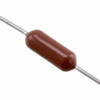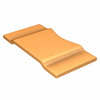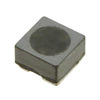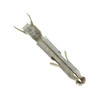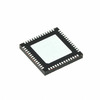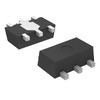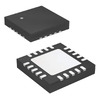Exploring the Pinout and Features of PIC16F1503 8-bit Microcontroller
The PIC16F1503 is recognized as a versatile 8-bit microcontroller, skillfully balancing affordability and functionality. It presents a range of memory options, like Flash, tailored to diverse requirements. This article delves into the intricacies of the PIC16F1503, exploring its specifications, practical applications, and the advantages it brings and those new to the field of microcontrollers.Catalog
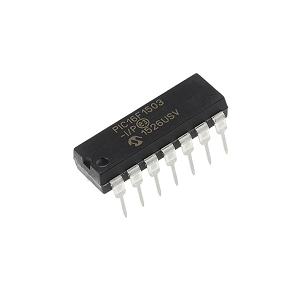
PIC16F1503 Microcontroller Overview
The PIC16F1503 stands as a versatile and efficient member of the mid-range PIC16 family, offering an 8-bit microcontroller solution. Celebrated for executing instructions swiftly within 200 milliseconds, it excels in time-sensitive scenarios. Utilizing CMOS flash technology and a reduced instruction set computing (RISC) architecture, this microcontroller simplifies complexity, fostering a streamlined and efficient process. This approach allows more refined control, valuable in compact and demanding systems. The PIC16F1503 features 3.5kB program memory, and 128 bytes of data memory. These elements align with the needs of moderately complex applications, where efficient memory use becomes a delicate art. The 12 input/output (I/O) pins provide diverse interfacing options, enabling connections to various peripherals and sensors in integrated systems.
With an 8-channel 10-bit analog-to-digital converter (ADC) and a 5-bit digital-to-analog converter (DAC), the PIC16F1503 embraces flexibility in analog signal processing. This capability proves beneficial in applications requiring sensor readings and control outputs, such as environmental monitoring systems or industrial automation. Operating at speeds up to 20MHz and supporting a voltage range from 1.8 to 5.5V, this microcontroller adapts gracefully across different environments, ensuring reliability in battery-powered devices where energy efficiency and durability are cherished.
In many practical applications, the PIC16F1503 is chosen for projects prioritizing simplicity and cost-efficiency. Its presence in any scenarios reflects a harmonious balance between performance objectives and resource limitations. The combination of features and its attractive pricing make the PIC16F1503 a sought-after option for pursuing straightforward yet robust solutions. Its adept handling of both analog and digital tasks positions it as a core component in various embedded systems.
Alternatives and Equivalents of PIC16F1503
• PIC16F1503-E/P
PIC16F1503 Pin Configuration

|
Pin Number |
Pin Name |
Description |
|
1 |
VDD |
IC supply pin |
|
13, 12, 11, 4, 3, 2 |
RA0, RA1, RA2, RA3, RA4, RA5 |
Port A GPIO pins (see datasheet for alternate functions) |
|
10, 9, 8, 7, 6, 5 |
RC0, RC1, RC2, RC3, RC4, RC5 |
Port C GPIO pins (see datasheet for alternate functions) |
|
14 |
VSS |
IC ground reference |
PIC16F1503 Footprint and CAD Model
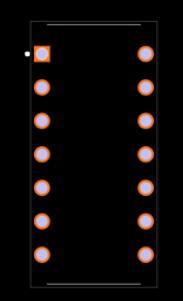

PIC16F1503 Specifications
Technical characteristics, features, and specifications of Microchip Technology PIC16F1503, along with components comparable to the PIC16F1503-E/P.
|
Type |
Parameter |
|
Factory Lead Time |
6 Weeks |
|
Package / Case |
14-DIP (0.300, 7.62mm) |
|
Number of Pins |
14 |
|
Number of I/Os |
11 |
|
Watchdog Timers |
Yes |
|
Packaging |
Tube |
|
Published |
2011 |
|
Part Status |
Active |
|
Number of Terminations |
14 |
|
Terminal Finish |
Matte Tin (Sn) |
|
Terminal Position |
DUAL |
|
Terminal Pitch |
2.54mm |
|
Base Part Number |
PIC16F1503 |
|
Supply Voltage-Max (Vsup) |
5.5V |
|
Interface |
I2C, SPI |
|
Mounting Type |
Through Hole |
|
Surface Mount |
NO |
|
Data Converters |
A/D 8x10b |
|
ROM (word) |
2048 |
|
Operating Temperature |
-40°C~125°C TA |
|
Series |
PIC® 16F |
|
JESD-609 Code |
e3 |
|
Moisture Sensitivity Level (MSL) |
1 (Unlimited) |
|
ECCN Code |
EAR99 |
|
Max Power Dissipation |
800mW |
|
Supply Voltage |
2.5V |
|
Frequency |
20MHz |
|
Pin Count |
14 |
|
Power Supplies |
2.5V/5V |
|
Memory Size |
3.5kB |
|
Oscillator Type |
Internal |
|
Voltage - Supply (Vcc/Vdd) |
2.3V-5.5V |
|
Core Processor |
PIC |
|
Program Memory Type |
FLASH |
|
Program Memory Size |
3.5kB 2K x 14 |
|
Supply Current-Max |
2mA |
|
Has ADC |
YES |
|
Data Bus Width |
8b |
|
DAC Channels |
YES |
|
On Chip Program ROM Width |
14 |
|
Low Power Mode |
YES |
|
Integrated Cache |
NO |
|
On Chip Data RAM Width |
8 |
|
Radiation Hardening |
No |
|
RAM Size |
128 x 8 |
|
uPs/uCs/Peripheral ICs Type |
MICROCONTROLLER, RISC |
|
Peripherals |
Brown-out Detect/Reset, POR, PWM, WDT |
|
Core Size |
8-Bit |
|
Connectivity |
I2C, SPI |
|
Bit Size |
8 |
|
DMA Channels |
NO |
|
PWM Channels |
YES |
|
Number of Timers/Counters |
3 |
|
CPU Family |
PIC |
|
Number of Programmable I/O |
12 |
|
RAM (words) |
128 |
|
Length |
10.5mm |
|
RoHS Status |
ROHS3 Compliant |
PIC16F1503 Features
Configurable Logic Cells (CLCs)
The PIC16F1503 offers configurable logic cells, adding flexibility to digital design. These cells create custom logic functions without extra components, catering to intricate applications. You can use this to replace external logic gates, minimizing both costs and board space while addressing specific project desires.
Integrated Temperature Indicator
A built-in temperature indicator enhances reliability by enabling precise temperature monitoring. This feature facilitates adjustments, ensuring devices stay within safe thermal limits, a great consideration in both industrial and consumer contexts.
8-channel 10-bit ADC
The microcontroller includes a multi-channel 10-bit Analog-to-Digital Converter, which is good for processing analog signals. Its eight channels allow for concurrent monitoring of different sensors, streamlining data acquisition. This supports a range of applications, from environmental analysis to sophisticated control systems.
5-bit DAC and Communication Interfaces
Equipped with a 5-bit Digital-to-Analog Converter, the microcontroller handles simple audio outputs and diverse signal generation tasks. Communication interfaces like MI2C and SPI enhance connection with peripherals, making it central to constructing resilient communication networks in embedded environments.
Standalone PWM and Timer Capabilities
Standalone Pulse Width Modulation outputs and advanced timers assist in accurate control tasks for motor control and power management. These features are often employed for various uses, including LED dimming and signal modulation, adding nuance to project execution.
Enhanced Core with 49 Instructions
The core of the PIC16F1503, crafted with 49 instructions, ensures swift task execution. This optimized instruction set caters to high-performance applications, balancing speed with power consumption and meeting the demanding needs of complex operations.
Advanced Reset Functionalities
Sophisticated reset mechanisms bolster microcontroller reliability amid power fluctuations or unexpected situations. These features enhance system resilience, minimizing downtime and safeguarding against potential data issues, offering peace of mind.
Versatile Operating Voltage and Temperature Ranges
Capable of functioning across wide voltage ranges and extended temperature conditions, the PIC16F1503 is suited for varied environments, from industrial settings to consumer electronics. This adaptability empowers to use the microcontroller in scenarios that demand resilience and efficiency.
Applications of PIC16F1503
Versatility in Programmable Logic
The PIC16F1503 reveals a remarkable ability to handle programmable logic tasks. With its powerful processing, it caters to crafting unique logic solutions across various applications, shaping performance and boosting reliability in complex systems. Its capacity for adaptation means it can align with diverse industry requirements, seamlessly integrating and customizing to suit distinct demands.
Integration in Mixed-Signal Processing
In mixed-signal processing, the PIC16F1503 efficiently manages both analog and digital signals. This aptitude is need for applications requiring smooth interaction between signal types. The microcontroller enables precise control and monitoring, proving great in projects demanding high accuracy and minimal noise interference. Others tap into its capabilities to innovate, refining designs for enhanced functionality.
Impact on Smart Appliances
Within smart appliances, the PIC16F1503 enhances automation and energy efficiency. It orchestrates various appliance functions, leading to notable energy savings. The microcontroller accommodates advanced features like adaptive learning and remote control, aligning with trends toward intelligent, connected home environments. Its application optimizes resource management, supporting sustainability initiatives.
Contributions to the Automotive Sector
The automotive domain gains from the PIC16F1503 in motor control and lighting systems. Its management of intricate control systems ensures smoother operation and longevity of vehicle components. It facilitates sophisticated features such as adaptive headlights and efficient motors, bolstering safety and driving pleasure. This participation highlights the shift toward smarter automotive technologies, echoing industry movements towards innovation.
Role in Industrial Applications
In industrial settings, the PIC16F1503 plays a role in automating production and enhancing system efficiency. Its use stretches from robotic controls to environmental monitoring. Employing this microcontroller heightens precision and reduces downtime, contributing to operational effectiveness and cost efficiency. Its adaptability supports the continual advancement of industrial technology, enabling industries to meet evolving demands.
Support in Medical Technologies
The PIC16F1503 is use in the medical field, contributing to reliable and precise diagnostic and therapeutic devices. It guarantees that systems function accurately and consistently, which is good in medical contexts where precision affects patient outcomes. The microcontroller is integral to innovations in patient monitoring and medical testing, enhancing the impact of medical technologies on healthcare solutions.
Utilizing the PIC16F1503
Engaging with Peripherals in Depth
The PIC16F1503 microcontroller stands out for its ability to seamlessly connect with a diverse array of peripherals, opening doors to numerous applications. Its analog-to-digital converter (ADC) smartly channels external inputs to specific GPIO pins, allowing the integration of components like voltage references and temperature sensors. This capacity enriches the microcontroller's proficiency in accurately capturing and analyzing external signals. Many exploit this capability when crafting systems that demand precise environmental data collection, ensuring that data flows smoothly into processing pipelines. This flexibility frequently results in sturdy and dependable systems.
Precision Handling with DAC
The 5-bit digital-to-analog converter (DAC) of the PIC16F1503 provides a versatile range of voltage outputs. It's particularly advantageous for signal refinement before further processing or when particular voltage is required for external interactions. Operating alongside comparators, the DAC enables fluent signal conversion, minimizing errors in sensitive applications. In industrial landscapes, the DAC’s precision proves in managing processes like automated feedback systems, where exact voltage control is needed.=
PIC16F1503 Package

PIC16F1503 Manufacturer Information
Microchip Technology Inc. leads the world in microcontrollers and semiconductor solutions, addressing a wide array of application needs. Their focus on quality and unwavering customer support reflects a journey of excellence witnessed in successful global implementations. The company demonstrates its pursuit of superior craftsmanship through precise manufacturing and thorough testing protocols. This dedication yields high-performance, reliable components for both groundbreaking and established technologies. Systematic quality checks nurture trust with their clients. Microchip's solutions have delivered substantial improvements in various sectors. For instance, their microcontrollers enhance energy efficiency and convenience in smart home devices. Looking forward, the company aims to broaden its technological breadth by embracing sustainable practices and diversifying products. This foresight ensures their edge in competition and aligns with ecological and societal progress, offering a model for sustainable growth in the semiconductor field.
Frequently Asked Questions [FAQ]
1. What is the maximum operating frequency of the Microchip PIC16F1503?
The PIC16F1503 can achieve speeds up to 20MHz. This capability opens doors to a range of applications where swift data handling is a priority. Balancing its clock speed with energy consumption becomes an intriguing challenge, enhancing its use in scenarios demanding both rapid performance and power efficiency.
2. What is the addressable program memory size of the PIC16F1503 microcontroller?
Boasting a program memory of 3.5kB, the PIC16F1503 supports intricate functionalities within a compact frame. Many often leverage coding efficiency and optimization to maximize this constrained space, unlocking the full potential of the device's capabilities.
3. What is the use of PIC16F1503?
Its low-power consumption renders the PIC16F1503 particularly apt for medical monitoring devices. In situations like wearable health monitors, power efficiency influences not only device performance but also user comfort, extending usage with minimal battery life.
4. What is the range of PIC16F1503 voltage?
Functioning between 1.8 and 5.5V, this microcontroller provides flexibility in power supply options. Others take into account how these voltage levels affect component compatibility and the overall robustness of the system.
5. How does the operating temperature of PIC16F1503 range?
The PIC16F1503 operates in temperatures from -40°C to 125°C, catering to both industrial and consumer needs. This adaptability ensures dependable performance across diverse environments, a consideration for targeting international markets with varying climates.
About us
ALLELCO LIMITED
Read more
Quick inquiry
Please send an inquiry, we will respond immediately.

MAX17043/MAX17044 Li+ Battery: Specifications, Pinout, and Datasheet
on October 28th
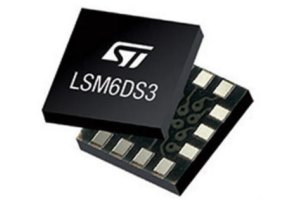
LSM6DS3 IMU Sensor: Comprehensive Pinout, Features, and Datasheet Analysis
on October 28th
Popular Posts
-

What is GND in the circuit?
on January 1th 2933
-

RJ-45 Connector Guide: RJ-45 Connector Color Codes, Wiring Schemes, R-J45 Applications, RJ-45 Datasheets
on January 1th 2486
-

Fiber Connector Types: SC Vs LC And LC Vs MTP
on January 1th 2079
-

Understanding Power Supply Voltages in Electronics VCC, VDD, VEE, VSS, and GND
on November 8th 1872
-

Comparison Between DB9 and RS232
on January 1th 1759
-

What Is An LR44 Battery?
Electricity, that ubiquitous force, quietly permeates every aspect of our daily lives, from trivial gadgets to life-threatening medical equipment, it plays a silent role. However, truly grasping this energy, especially how to store and efficiently output it, is no easy task. It is against this background that this article will focus on a type of coin cell battery that may seem insignificant on the...on January 1th 1709
-

Understanding the Fundamentals:Inductance Resistance, andCapacitance
In the intricate dance of electrical engineering, a trio of fundamental elements takes center stage: inductance, resistance, and capacitance. Each bears unique traits that dictate the dynamic rhythms of electronic circuits. Here, we embark on a journey to decipher the complexities of these components, to uncover their distinct roles and practical uses within the vast electrical orchestra. Inductan...on January 1th 1649
-

CR2430 Battery Comprehensive Guide: Specifications, Applications and Comparison to CR2032 Batteries
What is CR2430 battery ?Benefits of CR2430 BatteriesNormCR2430 Battery ApplicationsCR2430 EquivalentCR2430 VS CR2032Battery CR2430 SizeWhat to look for when buying the CR2430 and equivalentsData Sheet PDFFrequently Asked Questions Batteries are the heart of small electronic devices. Among the many types available, coin cells play a crucial role, commonly found in calculators, remote controls, and ...on January 1th 1537
-

What Is RF and Why Do We Use It?
Radio Frequency (RF) technology is a key part of modern wireless communication, enabling data transmission over long distances without physical connections. This article delves into the basics of RF, explaining how electromagnetic radiation (EMR) makes RF communication possible. We will explore the principles of EMR, the creation and control of RF signals, and their wide-ranging uses. The article ...on January 1th 1532
-

CR2450 vs CR2032: Can The Battery Be Used Instead?
Lithium manganese batteries do have some similarities with other lithium batteries. High energy density and long service life are the characteristics they have in common. This kind of battery has won the trust and favor of many consumers because of its unique safety. Expensive tech gadgets? Small appliances in our homes? Look around and you'll see them everywhere. Among these many lithium-manganes...on January 1th 1500













